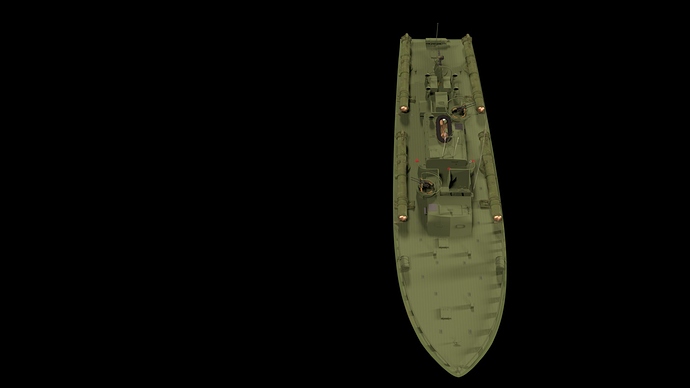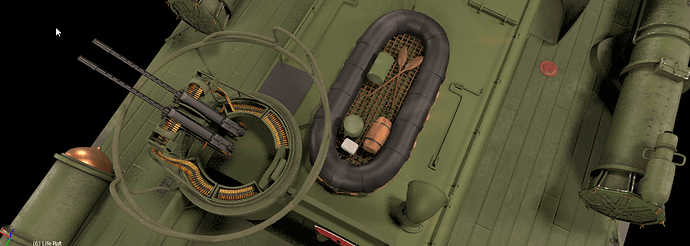The forward turret is pretty much complete except for texturing. There is a small error in the Limit Stop cage that I need to fix and the turret hatch has not yet been modeled.
The first image is of the bridge and the forward turret.
The second image is of both the forward and aft .50 cal turrets, though it is hard to see the details.
The third image is of the forward turret with most of the details I forgot to add in my last post here. There are still two details I need to fix, but it’s about 95-98% complete. Also, the aft turret is only half complete. I still need to add the Limit Stop cage. Also the aft turret had a canvass cover on the cage to protect the gunner from the spray of the boat at high speed. However, I’m not sure I’m motivated to create the canvass and the lashings to the cage. It’s not beyond my ability, but at some point I need to declare this model finished. I’m a very slow modeler and so there is a limit to my desire to include every tiny detail.
Although the modeling is progressing, I still have to model the life raft, life preservers, depth charges, the 20 mm cannon, and some small deck details such as the mushroom vents, gas caps, the drain for the bridge, and the push rod housings. I’ve toyed with the idea of modeling some of the crew members only because I’d like to update my B-17 model on Blend Swap and include the crew there as well. Practicing on modeling crew members here will make the B-17 update go much faster. However, I’ve never done characters or rigging before, and so this may be a bridge too far.
I’m not sure I have the motivation to model the .37 mm cannon that JFK had lashed to the forward deck on the last PT-109 mission. I don’t have any good drawings or blueprints and so although it would add some historical interest, almost no one knows the history of this boat and so I’m not sure my effort would enlighten that many people.
On Blend Swap some of my nature scenes have up to 5,000 downloads. But my historical scenes only have between 150 to 600. So so my assumption is that not many people are interested in history
And the .37 mm cannon on PT-109 was only on the boat for less than 24 hours. It was lashed to the forward part of the bow and that same evening, PT-109 was sunk when a Japanese destroyer running at about 40 knots accidentally collided with PT-109 at about 1 am in the morning, cutting the PT boat in half and sinking her. Two of the PT-109 were killed, one was badly burned because the PT boat used aviation fuel instead of diesel (the three 1,200 HP engines needed high octane gas to drive the PT boats up to 40 knots). The crew of the destroyer were unaware of the collision until later.
Anyway, if I can find some decent research on the .37 mm cannon, I might model the basic parts of it as it was lashed to the deck. But the truth is, my camera shots of the boat (even here) are going to be too far away for anyone to appreciate 80% of the detail I’ve put into this model.
For example, no one will ever notice the mushroom vents, the gas caps, the drain for the bridge, hinges on the hatches, the knobs on the bridge control panel, the accurate reconstruction of the limit stops on the turrets, or the dozens of other small details. But only matters that I know they are there.
But after all, I only do this historical modeling because I am a student of all kinds of histories.
I post all my models on Blend Swap as CC-0 for three reasons: I’m 70 years old and I don’t have time to become an expert to make a living or pocket change from my works; secondly, the meshes are probably so poor that no one could use them commercially; and finally, it’s just one of my many hobbies and so I feel like if someone can figure a way to make money off my work, more power to the–because I couldn’t.
There are experts out there who could do much better and in more detail than I have done so far (Chris Khun for one, Andrew Price for another, etc.) but for my skill level, I’m pretty satisfied with how accurate this model is. I spent weeks researching the PT-103 class boats (of which PT-109 was one), and so this model represents countless hours of research. Unfortunately, no one documented the different classes of PT boats, although there is more conjecture and speculation on PT-109 than on any other class of PT boats. In the end, I had to relay on photographs, forum discussions, recorded history, paintings, plastic models, etc. to come to a compromise of what PT-109 actually looked like. There is no unanimous agreement. Some modelers depict PT-109 as painted gray and some as painted green. Some say that the depth charges were removed after an accident and other say the damage was repaired and the depth charges were reinstalled.
All I can say is that after extensive research, I think this model is very close to what PT-109 looked like on its final mission.
I think that I may be just a couple / few weeks away from finishing this up as far as modeling goes.
But I have no freaking idea how I’m going to texture this beast because there are so many parts–some of which I have no idea how I would UV them. I’m hoping that I can get away with Smart UV Project. If not, I’m in big trouble.
In these images, only the hull and the torpedo tubes have been textured, but only as an experiment. The hull was simple to UV, but the torpedo tubes have lots of small parts and so I did a Smart UV Project. I think they turned out pretty good, although the texturing might be a bit over done. So I’m hoping that Smart UV Project will work for other parts of the boat. However, I will mark the seams for the major parts.
Criticisms and suggestions are always welcomed. Actually, I post my WIP here as a way to force me to make progress. Otherwise, I may procrastinate too much.
Sorry for the long post on not much progress, but I have to say that I’ve spent many hours on research and modeling and I’m pretty satisfied with the way this is turning out.






















